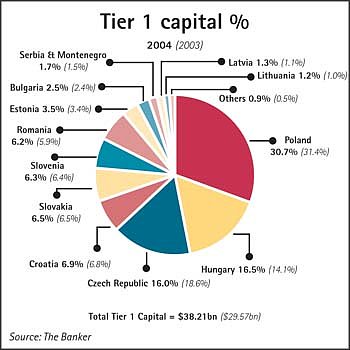Hungary’s OTP tops the list as central European banks enjoy good times and foreign players join the party.
The central Europe banking sector continues to show strong growth in all indicators, particularly profits, as foreign-owned institutions take an ever more dominant role in the region. While The Banker’s Top 100 central European listing is headed for the first time by Hungary’s expanding, locally-owned OTP Bank, almost 80% of the listing are now foreign-owned. This not only reflects the growth opportunities but the strong economic growth in the region in 2004 which ranges from 2.5% in Macedonia to 8.1% in Romania; this compares to a eurozone GDP growth figure of around 2% for the same period.
Aggregate Tier 1 capital for the Top 100 grew 29.2% to $38.21bn, aggregate assets grew 30.2% to $475.52bn and pre-tax profit grew 64.0% to $8.74bn. This compares with growth figures of 21.5%, 22.0% and 31.0% for the same parameters last year.
The top position in the listing this year is occupied by the Budapest-headquartered National Savings and Commercial Bank (OTP Bank). Ranked eighth last year, it has seen significant growth in both its domestic loan book and the loan books of its Slovakian subsidiary, OTP Bank Slovonska, and its Bulgarian subsidiary, DSK Bank. DSK saw a 63% growth in loans in 2004. To these two banks it added Romania’s Robobank in 2004 and Croatia’s Nova banka (69 in the current listing), in March 2005. Last year’s leader, Ceskoslovenská obchodní banka, slips to seventh following a 9.9% reduction in Tier 1 capital.
Foreign owners
Seventy-five of the banks in the listing are majority or wholly-owned by banks (69) or by banking consortia/non-banking institutions (6) that are headquartered outside the region. Of the remaining 25, as already stated Nova banka has been acquired, Jubanka and Delta banka in Serbia & Montenegro have been acquired by Alpha Bank of Greece and Banca Intesa from Italy, respectively, while the Romanian government has been seeking a foreign buyer for Banca Commerciala Romana for some time. Hebros Bank in Bulgaria has been acquired by HVB with a view to merging it with HVB Bank Biochim in 2006.
What then is the attraction of the region to banks from western Europe? A clue may be in figures for retail loans as a percentage of GDP given at a recent Standard & Poor’s seminar on emerging market banks, where the eurozone rate was in excess of 50% compared with 9%–15% for five countries from central Europe (Czech Republic, Poland, Slovakia, Hungary and Slovenia). There is obviously great scope for development in the retail loan market.
However, the main changes in the region may come about as a result of the UniCredit acquisition of HypoVereinsbank as it carries down to the subsidiary level since in certain countries each owns a major subsidiary and the local regulator may object. For example, in Croatia it will bring together UniCredit’s Zagrebacka banka (at 13 in the listing) and HVB Splitska banka (43), the irony being that the Croatian regulator made UniCredit divest itself of Splitska banka as a condition of being allowed to acquire Zagrebacka.



